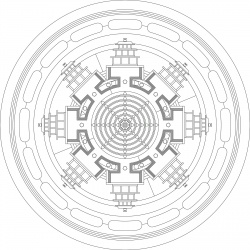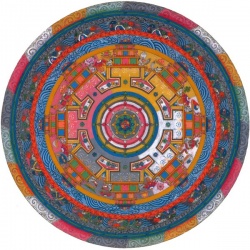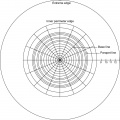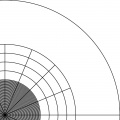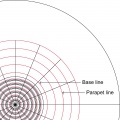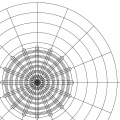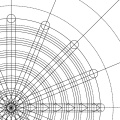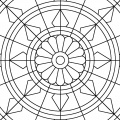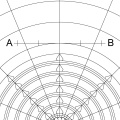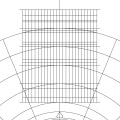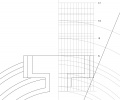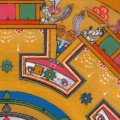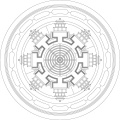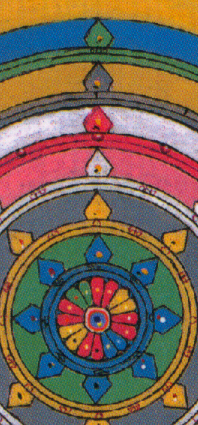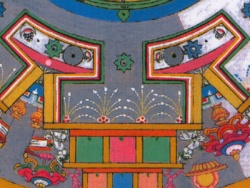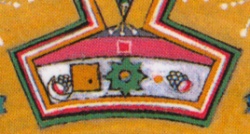Maṇḍala of Mahāsaṃvara Kālacakra
The maṇḍala of Mahāsaṃvara Kālacakra (dus 'khor sdom pa chen po) is unusual in that it is circular in shape, and that for a single storey palace it has eight doorways; it is also surrounded by 16 rather than the usual eight charnel grounds.
The deity himself is in two identical forms, differing only in that one is single and the other has a female consort. The single deity, Vajravega (rdo rje shugs) is considered to be the protector form of Kālacakra, and practitioners of Kālacakra sādhanas will know him from the protective sphere (srung 'khor) aspect of the practice. The deity with a female consort, Mahāsaṃvara Kālacakra, is a yidam in his own right, and it is his maṇḍala that is described here. Further information on these two deities can be found on this page.
The description given here is taken from three texts. First, two texts by Tāranātha: his sādhana for Mahāsaṃvara Kālacakra, "dpal sdom pa chen po'i sgrub dkyil gyi rim pa'i khyad par gsal byed", and his description of the drawing of the maṇḍala, "[[dus 'khor sdom chen gyi thig tshon gsal byed". Also used here is a text on maṇḍala drawing by Banda Gelek, "The Iluminating Sun-rays" (sgrol mgon zhabs kyis mdzad pa'i dkyil chog rgya mtsho'i thig tshon gsal byed legs bshad nyi ma'i 'od zer).
Particularly for checking seed-characters and other details, I have also refered to two other texts by the Sakya writer Jamyang Loter Wangpo ('jam dbyangs blo gter dbang po): his sādhana, "dpal dus kyi 'khor lo sdom chen gyi sgrub thabs nag 'gros su bkod pa" and his empowerment ritual, "dpal dus kyi 'khor lo sdom pa chen po'i dkyil 'khor gyi dbang chog bdud rtsi'i chu rgyun".
I have also refered to the original text in which the maṇḍala is first described: the fifth chapter of the Vimalaprabhā. This places great emphasis on the purification or symbolism of the maṇḍala, and some of this will be described below.
Tāranātha's description of the drawing of the maṇḍala starts with the drawing of the usual eight lines. For a description of how to draw these, see the three diagrams and the associated text here.
However, the lines that are normally refered to as central and diagonal lines are here all called central lines; there is a total of four of these intersecting, with eight end-points. The traditional count is of eight lines, considering each to start from the central point, finishing at its end-point. These are all here called central lines as they pass through the centre of the eight doorways.
Having drawn these four intersecting lines, the next step is to draw lines that bisect the angles between each of them. This is done by drawing further intersecting arcs from each central line. These four new lines, with eight end-points, are called medial lines (mtshams thig); as this maṇḍala has no corners, the term diagonal line (zur thig) is not employed.
The resulting 16 end-points indicate the positions of the eight doorways and the eight medial positions between them. As usual, the length of each line is 8 cubits, or 16 major units, or, door units (sgo tshad, DU).
Other terminology is to be understood in normal Kālacakra terms, and so each major unit consists of six minor units (cha chung, mu); the distance between opposite base-lines (in this case it is a diameter) is four cubits (khru, hasta) and a major unit is equal to a span (mtho, vitasti), or half a cubit. Also the width of each doorway is one major unit and each minor unit is equal to two fingers (finger-widths).
(Pic 1)To start the construction, divide the distance along a line from the extreme edge of the maṇḍala to the centre into 13 equal parts. Each of these parts is taken as one span (or DU), and so the extreme edge is 78 mus from the centre. Strictly speaking, the central and medial lines only extend 48 mus from the centre (to the inner edge of the perimeters), but in practice at least one or two need to be drawn to reach the outer extent of the maṇḍala.
Next, along one of the central lines, measure from the centre eight positions, each 1 DU apart, marking each one. Then, draw circles through each of these. The outermost of these circles intersects with the ends of the central and medial lines. It is the outer edge of the area known as the coloured ground (tshon sa, raṅgabhūmi) and is also the inner edge of the innermost perimeter. The fourth circle counting from the centre is the base line and the sixth is the parapet line.
These last two sections, between the fourth and sixth main circles, need to be subdivided with further construction circles. Between the fourth and fifth (Banda Geleg refers to this as the fifth section) divide off an inner and outer quarter (circles of radii 25.5 and 28.5 mus), and between the fifth and sixth, divide into two and then the outer half again into two (circles of radii 33 and 34.5 mus). Between the base line and parapet line circles, we now have six bands, for later constructing the walls, plinth, frieze, garlands, pipes and parapet (the last four are barely visible in the finished maṇḍala). The inner four circles need to be halved – in other words draw further circles inside of them, with radii 3, 9, 15 and 21 mus.
(Pic 2)The innermost eight circles, each with a radius 3 mus larger than the previous, mark out, respectively: the lotus, the wheels of awareness, earth, water, fire, wind and space, and the coloured ground. Each of these spaces now needs to be divided into three. So further circles are drawn, each one with a radious 1 mu greater than the previous. The spaces between these are then also halved with further circles. In other words, we need a set of 48 circles, the innermost having a radius of ½ mu, and the others with radii increasing in units of ½ mu.
(Pic 3)In this way, within the base line circle, other circles divide the area up, in each direction from the centre, into 48 spaces each of ½ mu width – 96 across the whole. There are eight regions marked out in this way, each 3 mus in width. For the eighth, the outside edge of which is the base line, the inner dividing lines can be ignored – or erased if they have been drawn. For the remaining circles, from the seventh down to the lotus, the outer three dividing lines are not final lines, and the outer two of these can be erased if they have been drawn. For the lotus, all three outer dividing lines can be erased. This leaves 21 final lines within the parapet line; the base line circle, the parapet line and the circles between the base and parapet lines, are construction lines, only parts of which will be final. In the diagram on the right, the circular construction lines that are needed are shown in red.
(Pic 4)On the inner line of the coloured ground (the circle with radius 21 mus), mark points 1 mu either side of where it intersects the eight central lines (in the cardinal and intermediate directions). In the diagram on the right, small circles have been drawn to indicate this. For each of these, draw long construction lines parallel to the central line, connecting these pairs of marks on opposite sides of the maṇḍala.
(Pic 5)These sets of parallel lines mark the positions of the spokes for the six wheels. To draw the spokes, further construction lines are effectively required, but in practice the following drawing could be done by simple measurement. If the lines are drawn, as shown in diagram to the right, they sit ⅔rds of the way between the central lines and the parallel construction lines either side of them. These new construction lines mark the position of the base of a wheel spoke on the circle that is the outer line of its hub. The circular construction line immediately beyond the hub indicates the position of the fattest part of the spoke. These are weapon wheels, and so the spokes are drawn sharp, coming to a point on the inside edge of the next hub (and the coloured ground for the outermost wheel), This is illustrated in the diagram on the right in which all construction lines, including one of the central lines, are shown as dashed. The large circle to the right in that diagram is the inner line of the coloured ground.
(Pic 6)For the lotus, the inner two circles, of radii ½ and 1 mu, mark out the seat and the receptacle. The space between the receptacle and the next circle, with radius of 3 mus, is for the petals. In this instance, 16 petals are required.
(Pic 7)The width of the lotus is equal to one door unit, 6 mus. We now need to measure a similar width across each base line. Tibetan texts on maṇḍala drawing are fond of stating when different components have the same dimensions, either as a means of checking that a drawing is done correctly or to use the same construction lines for more than one purpose. This is how it is described, but it is not actually necessary to draw long construction lines parallel to and either side of each central line, that are the same distance apart as the diameter of the lotus.
A line needs to be drawn that is perpendicular to the central line, and passes through the point of intersection of the central line and the base line circle. At this point Banda Gelek gives a somwhat obscure construction that is intended to ensure that the line is properly perpendicular. If I have understood him correctly this requires drawing two arc intersection points, either side of the central line. If, as in the diagram, the central line in question is the western one, then an arc is drawn of radius 4 DUs centred on the point of intersection of that central line with the base line, and another at the similar point on the southern central line. These arcs should intersect on the SW central line. Another pair of intersecting arcs are then drawn on the other side, this time using an arc centred on the northern central line. These should cross on the NW central line.
These two points, which in terms of coordinate geometry are at the points -24,24 and 24,24, are then joined to create the line we need. This line AB in the diagram to the right needs to extend for two DUs either side of the central line. The construction just described is not illustrated in that diagram. This line is not the base line (which in this maṇḍala is circular), but substitutes for it for the purpose of constructing the doorway and the toran above it. (I have some doubts that the construction method I have described for this line properly matches Banda Gelek's intention, but it does at least produce the correct result.)
(Pic 8)From this line, it is now necessary to draw a grid of construction lines, 1 mu apart, extending 2 DUs either side of the central line. This grid is extended upwards for a total of 5 DUs. From the bottom upwards, the first two DUs are for constructing the doorway, and the top three for the toran. For these: the first is divided into four, and the middle line ignored; the second is not divided at all; for the third, which is the first for the toran, divide into three, keeping the lower third and dividing it in two. The second DU for the toran is divided into quarters, the first and last of which are halved, and for the top DU divide it into three, and take the first quarter of the middle of these.
To put this in more simple terms, from the original horizontal line that is substituting for the base line, measure up, drawing 16 further horizontal lines: 1 ½, 3, 1 ½, 6, 1, 1, 4, ¾, ¾, 3, ¾, ¾, 2, ½, 1 ½ and 2 mus. This is all the same as the general Kālacakra maṇḍala toran, except for the middle DU of the toran. In the usual Kālacakra maṇḍala, the beams of the second and third stages are both ½ mu in thickness and the railings 1 mu; here, all four are ¾ mu. This grid is now used to create the doorway and toran.
(Pic 9)First, the lines for the wall structure need to be drawn. The starting point is on the lowest horizontal line of the grid, three minor units either side of the central line. Draw vertically up from the base line to the fourth horizontal line (counting the base as number 1); then out away from the central line to the ninth vertical either side, then up to the fifth horizontal. This forms the usual shape of the doorway. Then, from points halfway between the fourth and fifth vertical lines and the second horizontal line, draw up to the third horizontal, then out to the 12th verticals, and from there up to the fifth horizontal. This last vertical section is the outer line for the main toran pillars. Another pair of lines needs to be drawn from points on the third horizontal, halfway between the tenth and 11th verticals, up to the fifth horizontal, to form the inner lines for the pillars. The fifth line also is connected between the 12th verticals either side. This completes the main lines for the doorway, and these can now be connected with two of the circular lines for the wall structure that were described earlier. Notice in the diagram on the right that the lines for the porch-projections will need to be extended down a little in order to meet the two circles with which they need to connect – the base line and the next one out.
(Pic 10)The grid above the fifth horizontal is for constructing the toran. First, the ends of the sixth horizontal are dropped down to the fifth to form the beam for the first stage. Similarly, the ends of the seventh horizontal are dropped down to the sixth to form the railing. Between the seventh and eighth, horizontal pillars need to be drawn, with vertical lines, 2, 3, 7 and 8 mus right and left of the central line.
This process is repeated for the next two stages, up to the 14th horizontal. For the middle stage, pillars are drawn between the 10th and 11th horizontals, 1 ½, 2 ¼, 5 ¼ and 6 mus right and left of the central line. For the top stage, pillars are drawn between the 13th and 14th horizontals, 1, 1 ½, 3 ½ and 4 mus right and left of the central line.
The ends of the 14th and 15th horizontals are joined to create the beam for the roof top. The ends of the 16th horizontal are joined to points on the 15th, 5 mus right and left of the central line – this is to give the shape of the Chinese-style roof. Finally, between the 16th and 17th horizontals is drawn the flask, with parasols either side.
(Pic 11)Eight porches need to be drawn in this way, centred on each central line. Between each of the porches, the construction line circles drawn earlier beyond the walls, up to and including both the parapet line and the main original circle number eight (the inner edge of the perimeters) can now be used to create their equivalent final lines between the porches. These can be seen in the diagram on the right, in which the five-fold walls have been drawn, but for clarity, the gaps between them have not.
(Pic 12)The garlands are hardly visible at all and only small sections of the pipes and parapet. These details are clearer in the image on the right. Also notice in the image above that the lower corners of adjacent toran pillars overlap each other slightly. When drawing a maṇḍala a little artistic licence will be taken with the dimensions in order to avoid this; as would be the case with the flasks, which are unlikely to be drawn with their tops quite so wide as described in the texts. One point to notice that is equivalent to the dimensions in the general Kālacakra maṇḍala is that the end of the central line, where it meets the circle that is the outer edge of the coloured ground, precisely meets the middle of the top of the railing of the top stage of the toran.
(Pic 13)The central lines end on the eighth of the original circles; this is the outer edge of the coloured ground and the inner edge of the perimeters. We next need to draw circles for the perimeters, measuring out from the ends of the central lines, ½, 1, 1, 1, ½ and 1 DUs: radii of 51, 57, 63, 69, 72 and 78 mus (the last of those was drawn earlier). As with Kālacakra, these are for the perimeters of earth, water, fire, wind, space and the garland of light.
Also as with Kālacakra, charnel grounds are drawn in the outer half of the perimeter of fire and the inner half of wind; the difference with this maṇḍala is that 16 charnel grounds are drawn, rather then eight, and these are centred on each of the central and medial lines. Finally, for the last part of the main construction, the perimeter of wind is divided into three equal parts, the middle of which is for the vajra-garland, otherwise known as the perimeter of awareness. This will be coloured green, contrasting with the blue of the perimeter of space.
Colours
The background to the central lotus – the small area around the outer edges of the petals – is blue, and the lotus itself multi-coloured; Tāranātha has here that the receptacle of the lotus is black, and around it are narrow bands of red and white. This is referring to the manner of drawing a white moon disk, on top of which is a red sun disk and on top of that a black (or deep blue) rāhu disk. On this is drawn a blue vajra, the emblem of Mahāsaṃvara Kālacakra. The petals are green, although they may be drawn with other colours. On each of the petals in the cardinal and intermediate directions is a khaṭvāṅga, the colour of its direction. On the petals between these are skulls.
The spokes of the awareness wheel are blue and their background green. Of the double hub of that wheel, the outer is decorated with a garland of curved knives. The spokes of the earth wheel are yellow and their background black; the outer hub is decorated with wheels. The spokes of the water wheel are white and their background red; the rim of the hub is decorated with lotuses. The spokes of the fire wheel are red with their background white; the rim of the hub is decorated with jewels. The spokes of the wind wheel are black and their background yellow; the rim of the hub is decorated with swords. The spokes of the space wheel are green and their background blue; the rim of the hub is decorated with a garland of vajras.
All these emblems are drawn on the outer of the double hubs and are all the same colours as the spokes of their respective wheels. Tāranātha refers to these as hand-emblems (phyag mtshan), but this is somewhat misleading. The goddesses all have hand-emblems of curved knives, and the emblems just described are given in the Vimalaprabhā as decorations (garlands) on the wheel hubs. Also, the emblems or bindu (as in the drawing on the right) representing the goddesses are drawn on the spokes of the wheels and not on the hubs.
The coloured ground, the insides of the porches and so forth, are the colours of the directions in the following manner. From the medial line that is mid-way between the doorways in the north-east and east, to the medial line that is mid-way between the doorways in the south-east and south, the ground is coloured black. From there to the medial line that is mid-way between the doorways in the south-west and west, the ground is coloured red. From there to the medial line that is mid-way between the doorways in the north-west and north, the ground is coloured yellow. From there to the medial line that is mid-way between the doorways in the north-east and east, the ground is coloured white.
For the rest of the maṇḍala, the five-fold walls, the toran and so forth are all the same as with the main Kālacakra maṇḍala. On the receptacle of the central lotus is a seat of moon, sun and rāhu (white, red and deep-blue, respectively). On the eight petals in the cardinal and intermediate directions, on the spokes of the six wheels, inside each of the eight doorways and on each of the eight plinths, is a total of 72 corpses as seats. On the plinths, right and left of the doorways in the cardinal directions. near the pillars of the toran, are seats of the four elements for the nāgas, circular in the east, and so forth, as with Kālacakra (see the diagram on the right, which shows the eastern doorway and the circular seats of the element of wind).
In the centre is Bhairava Mahāsaṃvara, blue in colour with yellow consort, Vajraḍākinī (rdo rje ' 'gro ma). On the lotus petals between those in the cardinal and intermediate directions are eight flasks. On the 48 spokes of the (six) wheels, the vīrās (female) in the east and south-east are black, embracing yellow (male) consorts; in the south and south-west, they are red with white consorts; in the west and north-west they are yellow with black consorts; in the north and north-east they are white with red consorts. For all of these, the female is the chief deity. With the deity in the centre of the lotus, the male is the chief.
In the eight doorways and in the centre of the eight plinths between them, the deities in the east and south-east are black, in the south and south-west red, in the west and north-west yellow, and, in the north and north-east white. The emblems for all of these are curved knives on human corpse seats.
On the four elements on the plinth, right and left of the eastern door are two black male deities embraced by yellow consorts; similarly, in the south are red male deities embraced by white consorts, in the west are yellow male deities embraced by black consorts, and, in the north are white male deities embraced by red consorts. Also, on the plinths in the four directions are arranged offering goddesses as in Kālacakra.
In the earth perimeter: in the north-east is the rising full Moon and in the south-west the setting Sun. On the border between the perimeters of fire and wind are sixteen charnel grounds. The names of these are given by Tāranātha. The eight that are in the cardinal and intermediate directions have the usual following names:
E: Śūlabheda –mdung gis 'bigs pa
SE: Ucchiṣṭa – lhag ma can
S: Śavadahana – ro bsregs pa
SW: Ghorayuddha – drag po'i g.yul
W: Pūtigandha – rnag gi dri can
NW: Sarpadaṃśa – sbrul gyis zos pa
N: Saklinna – rul par gyur pa
NE: Bālamṛtyu – byis pa shi ba
The origin of the further eight is not clear. Tāranātha names them as follows:
L of SE: 'jigs par byed pa
R of SE: 'jigs rung
L of SW: drag po'i sgra can
R of SW: pheṭ ka ra
L of NW: ko la ha la
R of NW: kang ka le
L of NE: ha ha sgrog pa
R of NE: drag tu rgod pa
No description of the contents of these is available; Tāranātha simply states that they should be complete with all features.
Centred between the central and medial lines, in the spaces between the charnel grounds, draw fine designs of water. The wheels in the charnel grounds are not needed, neither are the emblems of the perimeter beings, the wheels and so forth in the stages of the toran, the deer, and so on, on the top of the toran, are also not needed.
The descriptions of the deity emblems by both Tāranātha and Banda Gelek are rather brief, and at the end of his description Tāranātha refers the reader to his sādhanā for further details. These details are given below.
The deities
The deities are described from the centre outwards, in four groups: the chief deity and eight goddesses on the central lotus, 48 ḍākinīs and their consorts on the main six wheels, 16 charnel ground goddesses in the doorways and on the plinths, and, two groups of attendant deities, nāgas (klu) and dhāraṇī (gzungs ma). According to Jamyang Loter Wangpo, the main 72 deities – those just listed except for the chief couple and attendant deities, all have corpse seats.
In the centre is Mahāsaṃvara Kālacakra and his consort Vajraḍākinī. His emblem was given earlier as a blue vajra. His seed-character is given in the Vimalaprabhā, the same as with the usual Kālacakra, a "huṃ" (his consort's seed is given as "phreṃ"). For all the other deities, bindu would probably be used to represent them, although emblems are given for many of them. In the following, their seed characters and colours are given. The central lotus has 16 petals; on the petals in the cardinal and intermediate directions are eight goddesses, the same as in the normal Kālacakra maṇḍala:[
E: a – Kṛiṣṇadīptā (nag mo 'bar ma)
SE: ha – Dhūmā (du ba ma)
S: āḥ – Raktadīptā (dmar mo 'bar ma)
SW: ha – Marīcī (rmig sgyu ma)
W: ā – Pītadīptā (ser mo 'bar ma)
NW: hā – Pradīpā (mar me ma)
N: aṃ – Śvetadīptā (dkar mo 'bar ma)
NE: haṃ – Khadyotā (me khyer ma)
On the other eight petals between these, are flasks of nectar, each suppressing certain bodily functions:
E: hi – marrow
E: hī – marrow
S: hṛi – blood
S: hṛī – blood
W: hḷi – faeces
W: hḷī – faeces
N: hu – urine
N: hū – faeces
On the spokes of the six wheels is a total of 48 ḍākinīs each with a male consort. In each case the ḍākinī is the chief deity.
Their names are simple – their seed character together with vajrā for the female and vajra for the male (male and female have different seeds). If seed characters are used in a maṇḍala, most likely just the ḍākinī seed will be used, and so these are given first with each entry.
As mentioned above, their colours follow a normal Kālacakra pattern: the ḍākinīs in the east and south-east are black and their consorts yellow, and so forth. In the original texts they are not given in the same order as given below; that original order is indicated by the number at the beginning of each entry. The order used here is simply clockwise from east and is the simplest to use when creating a maṇḍala.
As mentioned above, the Vimalaprabhā strongly emphasises the symbolism and purification function of the deities in the maṇḍala, as does Jamyang Loter Wangpo: "As the purification of these is highly important; it is vital that this is understood and contemplated with understanding."
The main 24 pairs of deities are associated with the 24 sites, or tantric meeting places: the pīṭha and upapīṭha, etc. These sites are given in the Vimalaprabhā and by Jamyang Loter Wangpo; these are given here at the end of each entry. Most of these do not have Tibetan language equivalents.
Also, the six wheels are each associated with the purification of the processes associated with one of the six centres in the body. Taken in halves, each half of a centre purifies (stops the activity of) one of the Zodiac signs and one of the twelve links (rten 'brel bcu gnyis, pratītyasamutpāda); also associated with each half is the attainment of one of the twelve levels. There are many further details given in the Vimalaprabhā.
First wheel; awareness:
Privities centre: Pramuditā (rab tu dga) & Vimalā (dri ma med pa)
Old age and death & Sagittarius – Birth & Scorpio
1. E: śi – śi-vajrā & sḷī-vajra (śi rdo rje ma & sḷī rdo rje) – Kāmarūpa ('dod gzugs)
8. SE: śī – śī-vajrā & sḷi-vajra – Mālava
2. S: ṣṛi – ṣṛi-vajrā & ḥpū-vajra – Jālakhya/Jālandhara
7. SW: ṣṛī – ṣṛī-vajrā & ḥpu-vajra – Devikoṭṭa (lha mo'i mkhar)
4. W: sḷi – sḷi-vajrā & śī-vajra – Oḍḍiyāṇa (o rgyan)
5. NW: sḷī – sḷī-vajrā & śi-vajra – Godāvarī
3. N: ḥpu – ḥpu-vajrā & ṣṛī-vajra – Pūrṇagiri
6. NE: ḥpū – ḥpū-vajrā & ṣṛi-vajra –Rāmeśa (dgag phyug)
Second wheel; earth:
Navel centre: Prabhākarī ('od byed pa) & Arciṣmatī ('od 'phro ba)
Involvement & Libra – Grasping & Virgo
1. E: dhi – dhi-vajrā & tḷī-vajra – Arbuda
8. SE: dhī – dhī-vajrā & tḷi-vajra – Lāḍadeśa
2. S: dṛi – dṛi-vajrā & thū-vajra – Munmunī
7. SW: drī – dṛī-vajrā & thu-vajra – Kośala
4. W: tḷi – tḷi-vajrā & dhī-vajra – Kāruṇyapāṭaka
5. NW: tḷī – tḷī-vajrā & dhi-vajra – Triśakunī (phur gsum)
3. N: thu – thu-vajrā & dṛī-vajra – Oḍraṃ
6. NE: thū – thū-vajrā & dṛi-vajra – Karmārapāṭaka
Third wheel; water:
Heart centre: Sudurjayā (sbyang dka' ba) & Abhimukhī (mngon du gyur pa)
Attachment & Leo – Sensation & Cancer
1. E: bhi – bhi-vajrā & pḷī-vajra – Kaliṅga
8. SE: bhī – bhī-vajrā & pḷī-vajra – Nepāla (bal po'i yul)
2. S: bṛi – bṛi-vajrā & phū-vajra – Harikela
7. SW: bṛī – bṛī-vajrā & phu-vajra – Himālaya
4. W: pḷi – pḷi-vajrā & bhī-vajra – Lampāka
5. NW: pḷī – pḷī-vajrā & bhi-vajra – Kāñcī
3. N: phu – phu-vajrā & bṛī-vajra – Candradvīpa (zla ba'i gling)
6. NE: phū – phū-vajrā & bṛi-vajra – Koṅkaṇa
Fourth wheel; fire:
Throat centre: Dūraṅgamā (ring du song ba) & Acalā (mi g.yo ba)
Contact & Gemini – Senses & Taurus
1. E: ḍhi – ḍhi-vajrā & ṭḷī-vajra – Mātṛigṛiha
8. SE: ḍhī – ḍhī-vajrā & ṭḷi-vajra – Siṃhala
2. S: ḍṛi – ḍṛi-vajrā & ṭhu-vajra – Prayāga
7. SW: ḍṛī – ḍṛī-vajrā & ṭhu-vajra – Suvarṇadvīpa (gser gling)
4. W: ṭḷi – ṭḷi-vajrā & ḍhī-vajra – Gṛihadevatā
5. NW: ṭḷī – ṭḷī-vajrā & ḍhi-vajra – Saurāṣṭra
3. N: ṭhu – ṭhu-vajrā & ḍṛī-vajra – Kollagiri
6. NE: ṭhū – ṭhū-vajrā & ḍṛi-vajra – Kāśmīra
Fifth wheel; wind:
Forehead centre: Sadhumatī (legs pa'i blo gros) & Dharmamegha (chos kyi sprin)
Name and form & Aries – Consciousness & Pisces
1. E: jhi – jhi-vajrā & cḷī-vajra – Nagara
8. SE: jhī – jhī-vajrā & cḷi-vajra – Samala
2. S: jṛi – jṛi-vajrā & chū-vajra – Mahendraśaula (dbang chen drag)
7. SW: jṛī – jṛī rdo rje ma & chu-vajra – Kulatā
4. W: cḷi – cḷi-vajrā & jhī-vajra – Kirātaka
5. NW: cḷī – cḷī-vajrā & jhi-vajra – Marudeśa
3. N: chu – chu-vajrā & jṛī-vajra – Sindhudeśa
6. NE: chū – chū-vajrā & jṛi-vajra – Gahvara
Sixth wheel; space:
Crown centre: Samantaprabhā (kun tu 'od) & The twelfth level, not specifically named (sa bcu gnyis pa)
Response & Aquarius – Misperception & Capricorn
1. E: ghi – ghi-vajrā & kḷī-vajra – Caritra
8. SE: ghī – ghī-vajrā & kḷi-vajra – Śrīhaṭṭaka
2. S: gṛi – gṛi-vajrā & khū-vajra – Harikela
7. SW: gṛī – gṛī-vajrā & khu-vajra – Tripurī ([[grong] gsum]])
4. W: kḷi – kḷi-vajrā & ghī-vajra – Kaumārikāpurī (gzhon nu ma grong)
5. NW: kḷī – kḷī-vajrā & ghi-vajra – Virajā
3. N: khu – khu-vajrā & gṛī-vajra – Vindhya
6. NE: khū – khū-vajrā & gṛi-vajra – Koṅka
The next two groups of eight are together called "the sixteen in the doorways and between" (sgo mtshams ma bcu drug). They are associated with the 16 charnel grounds and all are on wrathful wheels (charnel wheels, dur khrod kyi 'khor lo) and corpse seats.
A problem with these deities is that earlier their colours were given as the colours of the directions. In the sādhanās by both Tāranātha and Jamyang Loter Wangpo they are given as green in the cardinal directions and blue in the intermediate. So, which is correct? The Vimalaprabhā is not explicit, but seems to suggest, judging by their associations with other deities, that they are the colours of the directions. The colours green and blue are likely to be those of the wheels which are their seats.
These goddesses are in the doorways:
E: ña – ña-vajrā (green)
SE: ñā – ñā-vajrā (blue)
S: ṇa – ṇa-vajrā (green)
SW: ṇā – ṇā-vajrā (blue)
W: na – na-vajrā (green)
NW: nā – nā-vajrā (blue)
N: ma – ma-vajrā (green)
NE: mā – mā-vajrā (blue)
This next group of eight are on the plinths, between the doorways.
Between E & SE: da – da-vajrā (green)
Between SE & S: dā – dā-vajrā (blue)
Between S & SW: kṣa – kṣa-vajrā (green)
Between SW & W: kṣā – kṣā-vajrā (blue)
Between W & NW: ḥkā – ḥkā-vajrā (green)
Between NW & N: ḥka – ḥka-vajrā (blue)
Between N & NE: ha – ha-vajrā (green)
Between NE & E: hā – hā-vajrā (blue)
In the Jonang coloured maṇḍala on this page, wrathful wheels are also drawn in the 16 charnel grounds. This seems to be a mistake, and these are not described in any of the texts.
Next are two groups of attendant deities (rjes 'brang gi lha): eight nāgas together with their pracaṇḍā (rab gtum ma) consorts. These are on eight disks of the elements, right and left of the four doorways in the cardinal directions. Neither Tāranātha nor Banda Gelek give seed characters for these:
E: On circular disks of wind:[
Black Karkoṭaka (stobs kyi rgyu) & yellow Garuḍāsyā (mkha' lding gdong ma)
Black Padma (padma) & yellow Jambukāsyā (lce spyang gdong ma)
S: On triangular disks of fire:
Red Vāsuki (nor rgyas) & white Ulūkāsyā ('ug gdong ma)
Red Śaṅkhapāla (dung skyong) & white Vyāghrāsyā (stag gdong ma)
W: On square disks of earth:
Yellow Takṣaka ('jog po) & black Kākāsyā (khwa gdong ma)
Yellow Mahāpadma (padma chen po) & black Śvārāsyā (khyi gdong ma)
N: On semi-circluar disks of water:
White Ananta (mtha' yas) & red Gṛidhrāsyā (bya rgod gdong ma)
White Kulika (rigs ldan) & red Śūkarāsyā (phag gdong ma)
Also on the plinths are the 12 dhāraṇī, or offering goddesses. This is the same list of 12 as in the general Kālacakra maṇḍala. There is one on each section of plinth, plus four more that are given by Tāranātha as above and below. The position of these is not given, but it is likely that they would be placed in the four toran in the cardinal directions, as is the case in the main Kālacakra maṇḍala. That is how they are given here. In the image to the right is the section of plinth (white) between the west and north-west doorways. Left of centre is the yellow disk of the element of earth for one of the nāgas (the small black bindu/dot, the main yellow dot cannot be seen); in the middle is the wrathful wheel of ḥkā-vajrā; and, just to the right of that, the yellow bindu of an offering goddess.
E: black Gandhā (dri ma) & Mālā ('phreng ba ma)
S: red Dhūpā (bdug spos ma) & Dīpā (snang gsal ma)
W: yellow Lāsyā (sgeg mo) & Hāsyā (bzhad ma)
N: white Navedyā (bdud rtsi ma) & Amṛitaphalā ('bras bu ma)
A; E toran: green Nṛityā (gar ma)
A; W toran: green Vādyā (sgra ma)
B; S toran: blue Kāmā ('dod ma)
B; N toran: blue Gītā (glu ma sngon mo)
Finally, Tāranātha lists the perimeter beings arranged variously through the perimeter of wind.
These would be represented by various bindu, emblems or seed-characters. He does not go into details, but mentions the usual list: 35,000,000 spirits, the ten planets, Dhruva (the Pole Star), Agastya (ri byi), the 28 lunar mansions, the 12 zodiac signs, the 16 phases, the worldy protectors of the 10 directions, Nandi (dga, Mahākāla (nag po chen po), Ghaṇṭākarṇa (dril bu'i rna ba can), Bhṛiṅgī (nyam chung), Hāriti ('phrog ma), field protectors (zhing skyong, kṣetrapāla), messengers (pho nya, dūtī) and siddhas (grub pa), practitioners as numerous as the hairs on the body. For further general details on the perimeter beings, see this page.
